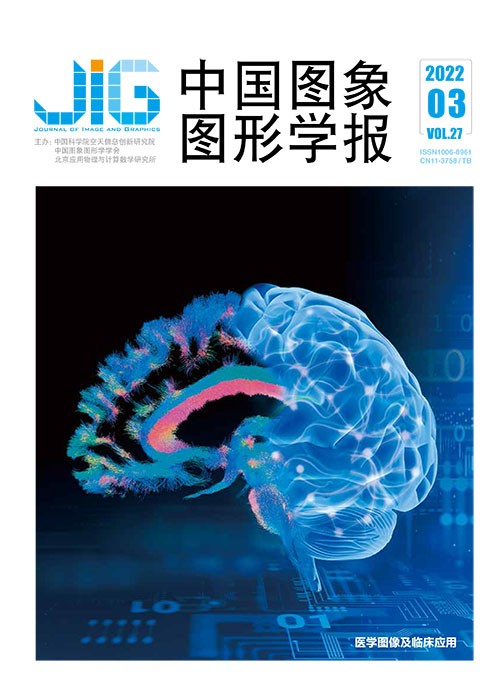
中国医学影像人工智能20年回顾和展望
蒋希1, 袁奕萱2,3, 王雅萍4, 肖振祥1, 朱美芦2, 陈泽华4, 刘天明5, 沈定刚6,7(1.电子科技大学生命科学与技术学院生物医学工程系, 成都 611731;2.香港城市大学电机工程系, 香港 999077;3.香港城市大学深圳研究院, 深圳 518057;4.郑州大学信息工程学院, 郑州 450001;5.美国佐治亚大学计算机科学系, 佐治亚雅典 30602, 美国;6.上海科技大学生物医学工程学院, 上海 201210;7.上海联影智能医疗科技有限公司, 上海 200230) 摘 要
在过去20年里,医学影像技术、人工智能技术以及这两项技术相结合的临床应用都取得了长足发展。中国在该领域的研究也取得卓越成就,并且在全世界范围内的贡献比例仍在逐步提高。为了记录和总结国内同行的科研成果,本文对中国医学影像人工智能过去20年的发展历程进行回顾和展望。重点分析了国内同行在公认的医学影像人工智能领域的国际顶级刊物Medical Image Analysis (MedIA)和IEEE Transactions on Medical Imaging (TMI)以及顶级会议Medical Image Computing and Computer Assisted Intervention (MICCAI)发表的论文,定量统计了论文发表数量、作者身份、发表单位、作者合作链、关键词和被引次数等信息。同时总结了近20年中国医学影像人工智能发展进程中的重要事件,包括举办的医学影像人工智能知名国际和国内会议、《中国医学影像AI白皮书》的发布以及国内同行在COVID-19(corona virus disease 2019)期间的贡献,最后展望了中国医学影像人工智能领域未来的发展趋势。上述统计结果系统性地反映了在过去20年里中国在医学影像人工智能领域所取得的突出成绩。许多研究论文的作者将数据和源代码公开给全世界共享,为全世界医学影像人工智能的科研和教学做出了杰出贡献。通过本文中国医学影像人工智能领域的发展历程,可为医学影像人工智能同行,尤其为新一代的学者和学生提供科研和教学参考,也为继续促进和加强国际合作交流,为全世界该领域进一步的蓬勃发展做出重要贡献。
关键词
A 20-year retrospect and prospect of medical imaging artificial intelligence in China
Jiang Xi1, Yuan Yixuan2,3, Wang Yaping4, Xiao Zhenxiang1, Zhu Meilu2, Chen Zehua4, Liu Tianming5, Shen Dinggang6,7(1.Department of Biomedical Engineering, School of Life Science and Technology, University of Electronic Science and Technology of China, Chengdu 611731, China;2.Department of Electrical Engineering, City University of Hong Kong, Hong Kong 999077, China;3.City University of Hong Kong Shenzhen Research Institute, Shenzhen 518057, China;4.School of Information Engineering, Zhengzhou University, Zhengzhou 450001, China;5.Department of Computer Science, University of Georgia, Athens GA 30602, USA;6.School of Biomedical Engineering, ShanghaiTech University, Shanghai 201210, China;7.Department of Research and Development, Shanghai United Imaging Intelligence Co., Ltd., Shanghai 200230, China) Abstract
The development of medical imaging, artificial intelligence (AI) and clinical applications derived from AI-based medical imaging has been recognized in past two decades. The improvement and optimization of AI-based technologies have been significantly applied to various of clinical scenarios to strengthen the capability and accuracy of diagnosis and treatment. Nowadays, China has been playing a major role and making increasing contributions in the field of AI-based medical imaging. More worldwide researchers in the context of AI-based medical imaging have contributed to universities and institutions in China. The number of research papers published by Chinese scholars in top international journals and conferences like AI-based medical imaging has dramatically increased annually. Some AI-based medical imaging international conferences and summits have been successfully held in China. There is an increasing number of traditional medical, internet technology and AI enterprises contributing to the research and development of AI-based medical imaging products. More collaborative medical research projects have been implemented for AI-based medical imaging. The Chinese administrations have also planned relevant policies and issued strategic plans for AI-based medical imaging, and included the intelligent medical care as one of the key tasks for the development of new generation of AI in China in 2030. In order to review China's contribution for AI-based medical imaging, we conducted a 20 years review for AI-based medical imaging forecasting in China. Specifically, we summarized all papers published by Chinese scholars in the top AI-based medical imaging journals and conferences including Medical Image Analysis (MedIA), IEEE Transactions on Medical Imaging (TMI), and Medical Image Computing and Computer Assisted Intervention (MICCAI) in the past 20 years. The detailed quantitative metrics like the number of published papers, authorship, affiliations, author's cooperation network, keywords, and the number of citations were critically reviewed. Meanwhile, we briefly summarized some milestone events of AI-based medical imaging in China, including the renowned international and domestic conferences in AI-based medical imaging held in China, the release of the "The White Paper on Medical Imaging Artificial Intelligence in China", as well as China's contributions during the COVID-19(corona virus desease 2019) pandemic. For instance, the total number of published papers in the past 20 years and the proportion of published papers in 2021 by Chinese affiliations have reached to 333 and 37.29% in MedIA, 601 and 42.26% in TMI, and 985 and 44.26% in MICCAI. In those published papers by Chinese institutes, the proportion of the first and the corresponding Chinese authors is 71.97% in MedIA, 69.64% in TMI, and 77.4% in MICCAI in 2021. The average number of citations per paper by Chinese institutes is 22, 28, and 9 in MedIA, TMI, and MICCAI, respectively. In all published papers by Chinese institutes, the predominant research methods were transformed from conventional approaches to sparse representation in 2012, and to deep learning in 2017, which were close to the latest developmental trend of AI technologies. Besides conventional applications such as medical image registration, segmentation, reconstruction and computer-aided diagnosis, etc., the published papers also focused on healthcare quick response in terms of COVID-19 pandemic. The China-derived data and source codes have been sharing in the global context to facilitate worldwide AI-based medical imaging research and education. Our analysis could provide a reference for international scientific research and education for newly Chinese scholars and students based on the growth of the global AI-based medical imaging. Finally, we promoted technology forecasting on AI-based medical imaging as mentioned below. First, strengthen the capability of deep learning for AI-based medical imaging further, including optimal and efficient deep learning, generalizable deep learning, explainable deep learning, fair deep learning, and responsible and trustworthy deep learning. Next, improve the availability and sharing of high-quality and benchmarked medical imaging datasets in the context of AI-based medical imaging development, validation, and dissemination are harnessed to reveal the key challenges in both basic scientific research and clinical applications. Third, focus on the multi-center and multi-modal medical imaging data acquisition and fusion, as well as integration with natural language such as diagnosis report. Fourth, awake doctors' intervention further to realize the clinical applications of AI-based medical imaging. Finally, conduct talent training, international collaboration, as well as sharing of open source data and codes for worldwide development of AI-based medical imaging.
Keywords
medical imaging artificial intelligence(AI) developmental history international cooperation quantitative statistics
|



 中国图象图形学报 │ 京ICP备05080539号-4 │ 本系统由
中国图象图形学报 │ 京ICP备05080539号-4 │ 本系统由